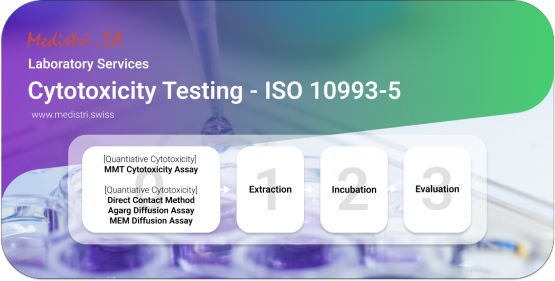👉 What is Cytotoxicity Testing?
According to ISO 10993–1, cytotoxicity is defined as:
“Cytotoxicity tests employing cell culture techniques can be used to determine the cell death (e.g. cell lysis), the inhibition of cell growth, colony formation, and other effects on cells caused by medical devices, materials and/or their extracts. If testing is performed, it shall be conducted in accordance with ISO 10993–5.”
The cytotoxicity testing is used to determine the toxicity of medical devices and materials. The test is carried out on all medical devices that come into touch with patients, as well as raw materials and devices that will be undertaking cleaning validation. Cytotoxicity testing evaluates whether a material can affect living cells. Medical Device Manufacturers are required to show that their devices are not cytotoxic.
👉 What are Quantitative Cytotoxicity Tests (MMT Cytotoxicity Assay)?
The current regulatory reforms on biocompatibility for devices (ANSI/AAMI/ISO 10993–5:2009) suggest that qualitative cytotoxicity tests are suitable for risk stratification, but that quantitative evaluation is favoured.
✅ MTT Assay: This quantitative method uses a dye called 3-(4,5-dimethylthiazol-2-yl)-2,5-diphenyltetrazolium bromide (which is abbreviated to MTT). This dye is a yellow water soluble chemical. It is cleaved by mitochondrial succinate dehydrogenase and forms formazan which has a purple tint. An extract of the test material is used in the MTT assay. MTT is added to the cells for 24 hours, so the presence of violet formazan may be detected using a plate reader.
The MTT can be used to assess the cytotoxicity of:
✔️ Medical Device’s Extractable Materials
✔️ Toxic substances
✔️ Environmental Toxins and Contaminants
✔️ Drug sensitivity profiles for patients with haematological malignancies and in primary screening of potential chemotherapeutic drugs.
👉 How is Cytotoxicity Testing Structured?
A Cytotoxicity Test consist of 3 steps:
1️⃣ Extraction: The device is immersed in an extraction medium and extracted in an inert vessel for a certain amount of time, at a predetermined temperature, and with a predetermined extraction ratio.
2️⃣ Incubation: The extract is incubated with the cells after extraction. There are numerous methods for accomplishing this: the cells can be pre-incubated (pre-grown) without extract or grown alongside the cells.
3️⃣ Evaluation: The effect of the extract on cytotoxicity is assessed after incubation to a subconfluent (80% confluency) cell lawn. Qualitatively or quantitatively.
👉 What are Qualitative Cytotoxicity Tests?
There are three qualitative cytotoxicity tests commonly used for medical devices.
Direct Contact Test: This method places a piece of test sample onto cells growing on culture medium, which are then incubated. During the incubation period, leachable chemicals in the test samples can permeate into the culture medium and come in contact with the cell layer. Reactivity of the test sample is indicated by degeneration, malformation, and lysis of cells around the test samples.
Indirect Contact Agar Diffusion Test: This method places a thin layer of nutrient-supplemented agar over the cultured cells. The test sample is placed on top of the agar layer, which are then incubated. The test material indicates cytotoxicity when a zone of lysed cells or degenerative is malformed.
MEM Elution Test: This approach use a variety of extraction medium and settings to test devices under real-world situations or to exaggerate such conditions. The extracts are transferred onto a layer of cells which are then incubated. The cells are inspected microscopically after incubation for deformity, degeneration, and lysis.
✅ The current regulatory reforms on biocompatibility for devices (ANSI/AAMI/ISO 10993–5:2009) suggest that qualitative cytotoxicity tests are suitable for risk stratification, but that quantitative evaluation is favoured (MMT Cytotoxicity Assay).
🎯 To learn more about our Cytotoxicity Testing services according to ISO 10993, visit on our website at www.medistri.swiss or directly contact our team at [email protected].
- The Medistri Team
#Medistri
